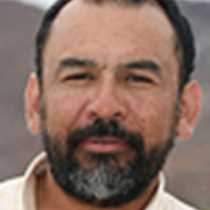San Esteban Island, Gulf of California
Sailing in the Gulf of California is not always easy, but we awoke this morning around San Esteban island for our first activities of the voyage. Everybody on the Sea Bird was very excited because this isolated volcanic island is the home for several endemic animals, like the piebald or “pinto” chuckwalla (the largest of all chuckwalla species), and also plants like an agave and two cactus species. As we approached to the shore on our Zodiacs, the naturalists received us with a native whip snake, just caught as the first guest arrived there. Many yellow-footed gulls were seen (but not disturbed) just nesting on the pebbled beach or defending territories aggressively against other yellow-footed gulls. Then we walked on the wide and well vegetated gravely arroyo and discovered many of the famous San Esteban chuckwallas, just under either the spiny jumping chollas, or big rocks. Also, the Gulf endemic spiny-tailed iguanas were seen in good numbers. Some individuals were posing naturally, so we enjoyed a long photographic session (picture above). The cardon, a giant and abundant cactus, was present everywhere with its big load of whitish flowers.
For the afternoon activities, we moved in the direction of San Pedro Martir, another completely isolated and volcanic island, famous for its breeding colonies of brown pelicans, blue-footed and brown boobies, and red-billed tropic birds, among other species. Our objective was to seek marine mammals. After some time of scanning the horizon, we finally found a pod of bottlenose dolphins that took a bow ride. Not far from that spot we also observed a big school of common dolphins in an apparently good disposition to show themselves around the boat. By the end of the afternoon, just about the time of a beautiful red sunset, two whales made their apparition: a humpback and a young Bryde’s whale, almost one next to the other. The darkness came down and we left the animals, hoping to have another great day tomorrow.
Sailing in the Gulf of California is not always easy, but we awoke this morning around San Esteban island for our first activities of the voyage. Everybody on the Sea Bird was very excited because this isolated volcanic island is the home for several endemic animals, like the piebald or “pinto” chuckwalla (the largest of all chuckwalla species), and also plants like an agave and two cactus species. As we approached to the shore on our Zodiacs, the naturalists received us with a native whip snake, just caught as the first guest arrived there. Many yellow-footed gulls were seen (but not disturbed) just nesting on the pebbled beach or defending territories aggressively against other yellow-footed gulls. Then we walked on the wide and well vegetated gravely arroyo and discovered many of the famous San Esteban chuckwallas, just under either the spiny jumping chollas, or big rocks. Also, the Gulf endemic spiny-tailed iguanas were seen in good numbers. Some individuals were posing naturally, so we enjoyed a long photographic session (picture above). The cardon, a giant and abundant cactus, was present everywhere with its big load of whitish flowers.
For the afternoon activities, we moved in the direction of San Pedro Martir, another completely isolated and volcanic island, famous for its breeding colonies of brown pelicans, blue-footed and brown boobies, and red-billed tropic birds, among other species. Our objective was to seek marine mammals. After some time of scanning the horizon, we finally found a pod of bottlenose dolphins that took a bow ride. Not far from that spot we also observed a big school of common dolphins in an apparently good disposition to show themselves around the boat. By the end of the afternoon, just about the time of a beautiful red sunset, two whales made their apparition: a humpback and a young Bryde’s whale, almost one next to the other. The darkness came down and we left the animals, hoping to have another great day tomorrow.




